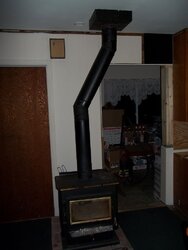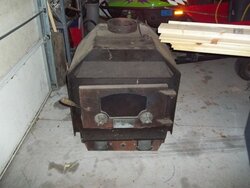I know this subject has been brought up a million times, but the threads usually leave me more confused than I was before I read them. We already have one stove connected, but recently bought another for $25 that we were just going to put in the pole barn. We decided that we want the new stove in the house as it is better. First, what I would like to know, is what exactly are the dangers of connecting an 8 inch stove flue to a 6 inch chimney? Second, would it be alright to try out the new stove and keep an eye on the chimney temperatures? Thanks
8 inch Stove to 6 inch Chimney Question?
- Thread starter Knight63
- Start date
-
Active since 1995, Hearth.com is THE place on the internet for free information and advice about wood stoves, pellet stoves and other energy saving equipment.
We strive to provide opinions, articles, discussions and history related to Hearth Products and in a more general sense, energy issues.
We promote the EFFICIENT, RESPONSIBLE, CLEAN and SAFE use of all fuels, whether renewable or fossil.
You are using an out of date browser. It may not display this or other websites correctly.
You should upgrade or use an alternative browser.
You should upgrade or use an alternative browser.
- Status
- Not open for further replies.
It's not the chimney temps, it's draft. The stove with the bigger flue needs more air passing through it to maintain combustion.
What is the stove make and model we are talking about here? Can you post some pictures of the current flue setup and of the new stove?
What is the stove make and model we are talking about here? Can you post some pictures of the current flue setup and of the new stove?
Monosperma
Member
I have a horse in this game too; I am trying out going from 8 to 6. Is there a genuine safety issue? Is there anything wrong with giving it a try to see if the draft is sufficient necking down to a 6? If one is not getting smoke where it's not wanted, and if the fire burns well, what's the harm? Looking at the inside of my BK KEJ1101, with the bypass closed, the gasses vent out a very small area anyway, then go to an 8" exit meant for an 8" pipe. The only time there is big draft out would be when the bypass is open - a rare occurrence with this stove. Still, I've had no vent problems reloading, and minor, tolerable smoke with a cold start, and that issue may actually have a cause unrelated to flue size. I'd love to hear more opinions on this.
Some manufacturers state in their literature that it is OK to use a 6in chimney on an 8in flue collar. If I recall BK was one of them I believe (but i think there were caveats) and VC another, so long as the user didn't run the stove in "fireplace mode" with the doors open?
The thing is, most insurance companies want the stove installed according to the specs in the manual. If it says to run an 8in chimney, and you do not, and you have a problem, you are putting yourself at risk of not being covered if they were under the impression that it was installed by the book.
pen
The thing is, most insurance companies want the stove installed according to the specs in the manual. If it says to run an 8in chimney, and you do not, and you have a problem, you are putting yourself at risk of not being covered if they were under the impression that it was installed by the book.
pen
Here's the pictures. After the chimney goes through the ceiling it turns into stainless steel triple wall pipe. It is 20-25 feet altogether. The stove currently in the house is an Englander( not sure which model, but it is rated at 1800 sq ft.) and the new stove is an Aurora ( also not sure of the model). Thanks


Unfortunately, I don't know of another way to upload them. Right now the chimney goes straight up from the stove for about 2.5 feet, then turns into a 45 degree angle for about 2 feet, and then turns straight up again for about a foot before it goes through the ceiling. It then is stainless steel triple wall pipe going straight up for about 20 feet. The new stove would be set up about the same way.Pic's do not seem to be appearing.
pen
That should be plenty of chimney, & I'm thinkin once you get a draft to start, you may not have an issue until you reload. As long as you follow the proper steps - open the primary - wait - open the load door very slowly - you should be fine... As pen indicated, your manual & your inspector may say otherwise...
gamesandguns
Member
We have a stove set up this way. The stove is an 8" but the existing chimney was 6". The draft is slow to start but once the stove gets up to temp we never have combustion issues. We do get some smoke coming out the door when adding more wood. I assume that's from the flue reducer but its in an outbuilding so I could care less.
fox9988
Minister of Fire
I ran a pre-epa 8" stove for years on 9' (total) of 8" pipe. The draft was fine, no smoke spillage. Moved the stove to a new house, used a 8-6 reducer at the flue collar with 8' single wall and 8 ' class A. The draft was fine during the burn but I had some smoke spillage with both stove doors open. Three more ft of class A may have solved the spillage.
Knight your going from a 6" collar on the stove to a 8" flue...right? Every house set up is different, so I think the only true way to find out is to get an adapter, hook it up and run it. It can go either way, too much draft or not enough. I am dealing with too much right now and generally the answer is a flue damper. Not enough is a different story and may or may not be worth the effort/money.
Nope, I'm going from an 8 inch stove to a six inch chimney. I think we are just going to try it out unless I find out that it isn't safe to do. ThanksKnight your going from a 6" collar on the stove to a 8" flue...right? Every house set up is different, so I think the only true way to find out is to get an adapter, hook it up and run it. It can go either way, too much draft or not enough. I am dealing with too much right now and generally the answer is a flue damper. Not enough is a different story and may or may not be worth the effort/money.
It's hard to tell but the current 6" stove appears to be a more modern stove. What is the problem you are trying to solve? The reason I ask is the old stove looks like it will need a lot more hearth and clearances
The main things we want is better draft control, easier ash removal, and more space for wood for longer burn times. It is hard to tell from the pictures, but the stove that is not hooked up is significantly bigger. ThanksIt's hard to tell but the current 6" stove appears to be a more modern stove. What is the problem you are trying to solve? The reason I ask is the old stove looks like it will need a lot more hearth and clearances
Woodsrover
Member
For what it's worth, I ran my VC Vigilant (8" collar) into a home-made 8-6 reducer and up a 6" Duravent chimney for years and it was just fine. The chimney was three stories high so I think that helped.
My personal opinion is that you should not do it. Sure, I hear all the folks about who are making it work under their specific conditions, but I just think you are asking for trouble. Remember, once you start building up some deposits in the 6" chimney, its going to be less. Just my 2 cents worth ....... I'm a retired safety professional so obviously biased.
rob z.
Member
- Nov 6, 2012
- 9
I am running a VC Vigilant with 8" single wall pipe that goes up 3 feet, makes a bend to horizontal and is reduced into a 6" metalbestos pipe that goes out through the wall to a T and straight up for two stories. It draws fine. In fact, I was worried it would draw too well so I added a damper in the 8" pipe just in case but haven't needed it (except for when burning too much pallet pieces/hardwood floor cutoffs). I just have to open the main damper on the stove before opening the doors or lid to add wood or else it will smoke. I would say you will be OK as long as you keep all the bends twists and contortions to a minimum. If you have issues with too much creosote building up it's because the smoke is not staying hot enough in the stove pipe and you might consider building a masonry chimney instead.
flhpi
Burning Hunk
Other than possible draft issues there is something else to consider. When you go from 8 to 6 it creates an area that contains smoke and combustible gases where the 8 is decreasing to 6. This could cause an issue. My old vermont could run a 6 or 8 but it was determined before the gases went up the chimney.
Some have done it without issues I just wanted to give you the possibility of a safety issue. I am a little gun shy on that kind of stuff. Plus a friends house burnt down this week, wood burner is probable cause. I never use the minimum criteria anyway, over engineer what I can.
Some have done it without issues I just wanted to give you the possibility of a safety issue. I am a little gun shy on that kind of stuff. Plus a friends house burnt down this week, wood burner is probable cause. I never use the minimum criteria anyway, over engineer what I can.
- Status
- Not open for further replies.
Similar threads
- Replies
- 5
- Views
- 498
- Replies
- 3
- Views
- 1K
- Replies
- 0
- Views
- 423
- Replies
- 2
- Views
- 838



